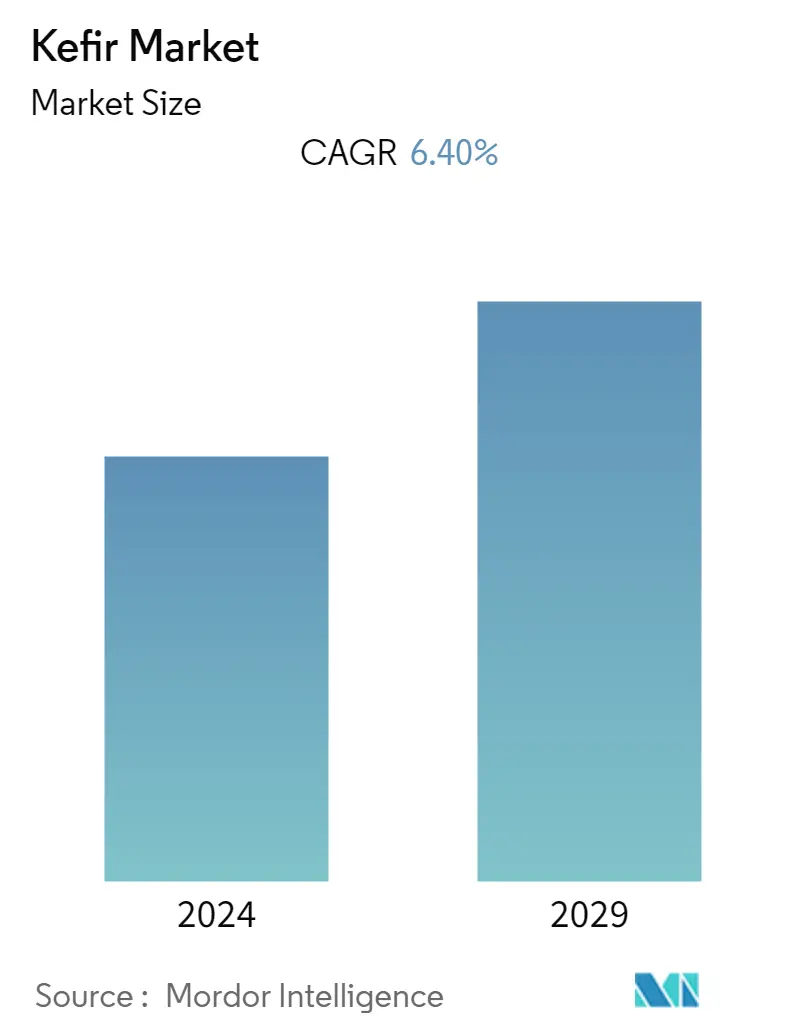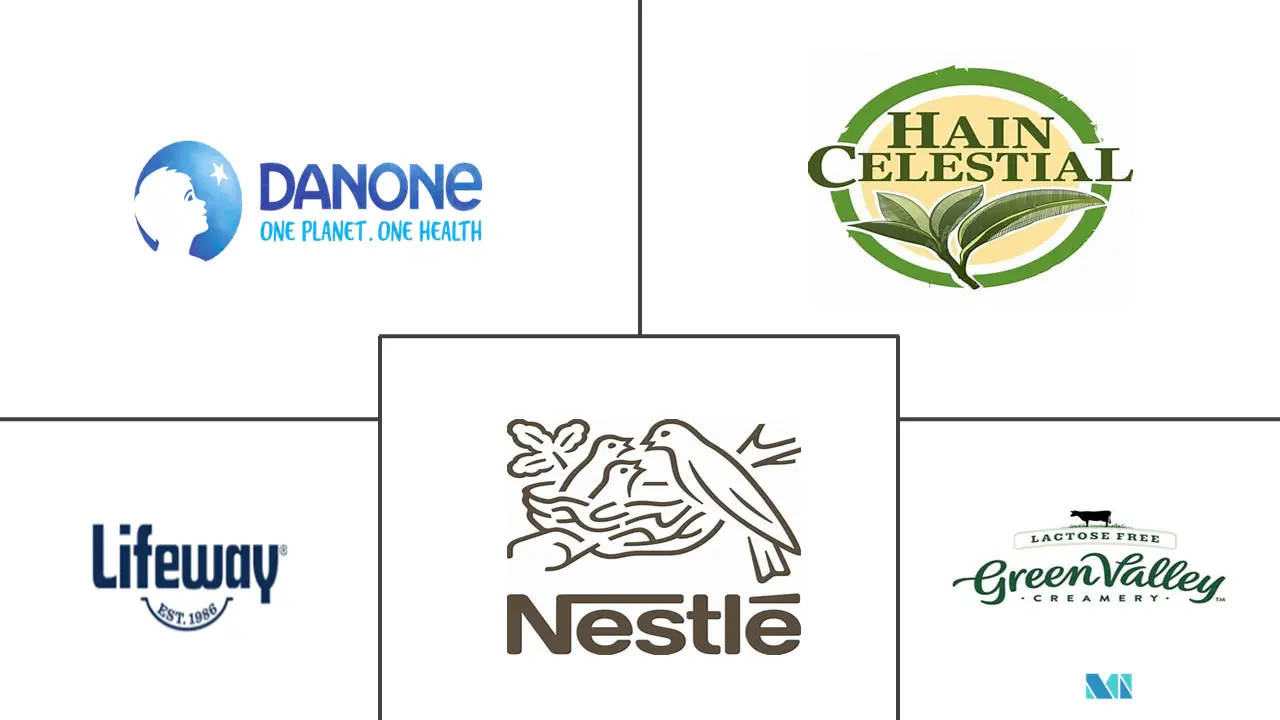Market Size of Kefir Industry

| Study Period | 2019 - 2029 |
| Base Year For Estimation | 2023 |
| CAGR | 6.40 % |
| Fastest Growing Market | North America |
| Largest Market | Europe |
| Market Concentration | Low |
Major Players
*Disclaimer: Major Players sorted in no particular order |
Kefir Market Analysis
The growth rate of the kefir market is expected to be 6.4% per year over the next five years.
The growing health consciousness of consumers is expected to drive up demand for probiotics, including kefir. In contrast to other fermented foods, kefir is made from kefir grains, which contain a distinct and complex combination of lactic acid- and acetic acid-producing bacteria and lactose-fermenting yeast. Kefir demand is projected to increase over time as more people come to understand how important gut health is for preserving weight, energy levels, and general physical health.
Manufacturers have started making and selling foods with specific health claims because people are becoming more aware of the link between nutrition and health and are becoming more interested in eating healthier. In western markets, where consumers adopt a holistic approach to healthy living, probiotic use is on the rise. Thereby, the demand for kefir has been strong due to its many health benefits. Utilizing the space, players are launching innovative products in the marketplace. For instance, in February 2021, Lifeway Foods launched new functional kefir products to support immunity and help consumers improve their overall health. 3.5-oz Functional Shot Multipacks and Organic Grass Fed Kefir
The ProCon Organization says that by 2022, 59% of the people who live in Canada will have trouble digesting lactose. Since this condition can't be cured but can be managed, more people are looking for foods that don't contain lactose. So, the benefits of kefir for people who can't handle lactose have made it more popular among lactose-intolerant people.
Kefir Industry Segmentation
Kefir is a fermented drink similar to thin yogurt made from kefir grains.
The kefir market is segmented based on form, category, type, distribution channel, and geography. By form, the market is segmented into organic and conventional. By category, the market is segmented into flavored and unflavored kefir. By product type, the market is segmented into milk and water-based kefir. By distribution channel, the market is segmented into supermarkets, hypermarkets, convenience stores, online retail stores, and other distribution channels. By geography, the market is segmented into North America, Europe, Asia-Pacific, South America, the Middle East, and Africa. For each segment, the market sizing and forecast have been done based on value (in USD million).
Kefir Market Size Summary
The kefir market is poised for significant growth, driven by increasing consumer awareness of the health benefits associated with probiotics. As more individuals recognize the importance of gut health in maintaining overall well-being, the demand for kefir, a fermented drink made from kefir grains, is expected to rise. This trend is particularly pronounced in Western markets, where there is a growing interest in holistic health approaches. Manufacturers are responding by introducing innovative kefir products with specific health claims, catering to the rising demand for functional foods. The popularity of kefir is further bolstered by its appeal to lactose-intolerant individuals, as it offers a digestible alternative to traditional dairy products.
In Europe, kefir consumption is on the rise, especially in Eastern European countries where it is a staple for digestive health. The UK and Germany also see increasing demand for kefir due to its perceived benefits for gut health, immunity, and digestion. The competitive landscape of the kefir market is marked by the presence of both global and local players, such as Lifeway Foods, Nestle, and Danone, who are investing in research and development to meet diverse consumer needs. These companies are also expanding their product offerings and exploring untapped markets to strengthen their market position. The kefir market's growth is supported by a broader shift towards preventive health measures and the increasing popularity of probiotic-rich beverages.
Kefir Market Size - Table of Contents
-
1. MARKET DYNAMICS
-
1.1 Market Drivers
-
1.2 Market Restraints
-
1.3 Porter's Five Forces Analysis
-
1.3.1 Bargaining Power of Buyers/Consumers
-
1.3.2 Bargaining Power of Suppliers
-
1.3.3 Threat of New Entrants
-
1.3.4 Threat of Substitute Products
-
1.3.5 Intensity of Competitive Rivalry
-
-
-
2. MARKET SEGMENTATION
-
2.1 By Form
-
2.1.1 Organic
-
2.1.2 Conventional
-
-
2.2 Category
-
2.2.1 Flavored kefir
-
2.2.2 Non-flavored kefir
-
-
2.3 Product Type
-
2.3.1 Milk Kefir
-
2.3.1.1 Dairy based
-
2.3.1.2 Non-dairy based
-
-
2.3.2 Water Kefir
-
-
2.4 By Distribution Channel
-
2.4.1 Supermarkets/Hypermarkets
-
2.4.2 Convenience Stores
-
2.4.3 Online Retail Stores
-
2.4.4 Other Distribution Channels
-
-
2.5 Geography
-
2.5.1 North America
-
2.5.1.1 United States
-
2.5.1.2 Canada
-
2.5.1.3 Mexico
-
2.5.1.4 Rest of North America
-
-
2.5.2 Europe
-
2.5.2.1 Germany
-
2.5.2.2 United Kingdom
-
2.5.2.3 Italy
-
2.5.2.4 Spain
-
2.5.2.5 France
-
2.5.2.6 Russia
-
2.5.2.7 Rest of Europe
-
-
2.5.3 Asia-Pacific
-
2.5.3.1 China
-
2.5.3.2 Japan
-
2.5.3.3 India
-
2.5.3.4 Australia
-
2.5.3.5 Rest of Asia-Pacific
-
-
2.5.4 South America
-
2.5.4.1 Brazil
-
2.5.4.2 Argentina
-
2.5.4.3 Rest of South America
-
-
2.5.5 Middle-East and Africa
-
2.5.5.1 South Africa
-
2.5.5.2 United Arab Emirates
-
2.5.5.3 Rest of Middle-East and Africa
-
-
-
Kefir Market Size FAQs
What is the current Kefir Market size?
The Kefir Market is projected to register a CAGR of 6.40% during the forecast period (2024-2029)
Who are the key players in Kefir Market?
Lifeway Foods, Inc., Nestle SA, Danone SA, The Hain Celestial Group, Inc. and Green Valley Creamery are the major companies operating in the Kefir Market.

